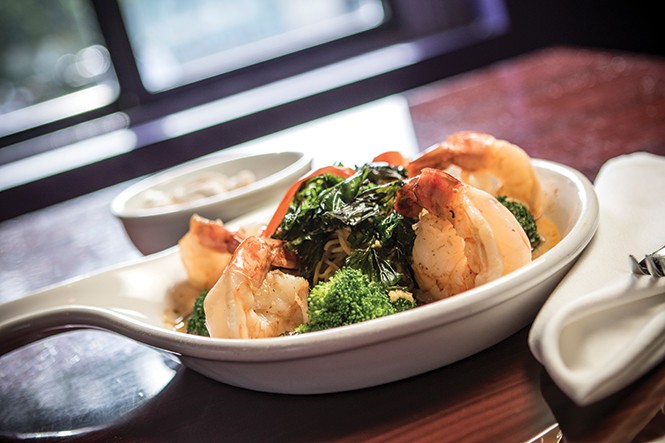
- Ekamai Thai garlic noodle prawns
One of the hip-and-happening districts in Bangkok is the Ekamai-Thonglor area. It's bustling with bars, cafes, restaurants and nightclubs, as well as the young, trendy crowds that frequent them.
The Ekamai Thai restaurants in downtown Salt Lake City and Sugar House are also hip—if perhaps not so trendy—and tend to attract a youngish clientele. Each location is different, but there's an irreverence I like, such as walls that look like they were tagged and restrooms with huge male and female symbols painted on them. There's also contemporary alternative music playing usually—the type of tunes you'd most likely hear on KRCL 90.9. The Ekamai Thai restaurants here aren't shrines to Thai cuisine or culture—just comfy, friendly and cool spots where you can get a taste of both.
The petite, downtown Ekamai Thai has a limited menu, so my review is mostly based on visits to the larger Sugar House venue, situated in an old house next to Blue Boutique, across from Sugar House Park. At the downtown store, near Caputo's, the Ekamai menu features six menu items that change daily, although some standards like massaman beef curry and yellow-curry chicken make the cut all six days a week (Monday-Saturday) that the cafe is open. Customers can choose one item from the menu for $5.99 (served with rice) or two items for $8.49, which includes an egg roll. In addition, there are a handful of house specials ($9.49): papaya salad, green-curry pasta, pad seiw and dunken noodles among them. Needless to say, at these prices lunch at the downtown location is quite popular and seating is sparse.
Ekamai in Sugar House is open for dinner nightly at 5 p.m. and serves a lunch buffet ($11.95) six days a week, Tuesday through Sunday. The regular Ekamai menu is also available at lunchtime if you'd prefer to stray from the buffet.
The service at Ekamai couldn't be more friendly. But then, that's something I say about almost every Thai restaurant I visit. The Thai people are some of the warmest, most generous and happiest people I've ever met. That's a big generalization, I realize, but true in my experience. In addition to a number of Thai servers—mostly from Bangkok—at the Sugar House Ekamai, there's also plenty who aren't Thai-born, such as a fantastic woman named Miriam, who also is part of the team. I could build an entire restaurant around friendly, top-notch servers like her.
After being seated quickly, I found myself surprised a bit at the wine list. It isn't lengthy, but there are some jewels, including Santa Margherita Prosecco, Ferrari-Carano Chardonnay, d'Arenberg The Hermit Crab Viognier, A to Z Pinot Gris, Plantagenet Pinot Noir and St. Supery Cabernet Sauvignon, plus decent sake and beer options.
So, we settled on a versatile wine—Fisher Unity Rosé ($35/bottle)—and dug into an appetizer of curry dumplings ($7). I'm not used to seeing dumplings on Thai menus, and these are standard pork- and cabbage-stuffed potstickers—the same as those found in Chinese restaurants—but bathed in a sweet and spicy coconut-green curry. It's a nice starter, as is the chicken satay ($9), which is four skewers of grilled, boneless chicken breast that somehow isn't cooked to death, but surprisingly tender. My only complaint was that more of the delicious peanut dipping sauce didn't come with the skewers; we quickly ran out.
My favorite Ekamai appetizer, however, is the chicken larb ($8). Although you'll find larb on most Thai menus, it is the national dish of Laos: a minced meat salad, made typically with pork or chicken seasoned with fish sauce, chilies, onion or shallots, kaffir lime leaves, garlic and Thai basil or cilantro. The meat—in this case, chicken—is minced and cooked, then served with large lettuce leaves you use at the table to make into "cups" or taco-style wraps. The larb at Ekamai is very good, but not as spicy as I'm used to. And it occurred to me afterward that not once during our visits did anyone ask how spicy/hot we wanted any of our dishes, as is the norm in most Thai eateries. In general, the dishes at Ekamai are prepared on the mild side.
A dish I'd highly recommend is the garlic noodle with tiger prawns ($20). This was a generous serving of a half-dozen or so large, plump grilled prawns that were tender and delicious. They're served atop a mound of thin, ramen-style egg noodles stir-fried with garlic and served with broccoli and deep-fried, crispy basil and onions, all topped with chili sauce.
I hate to say it, but a bowl of yellow curry ($12) with chicken, potatoes and carrots was pedestrian at best. As with many Ekamai dishes, it came with steamed broccoli and shredded carrots on the side. In fact, almost every dish we ordered was garnished with shredded carrots. I can't say we were too impressed with the mahi mahi see ew ($18), either. See ew is a popular soy-sauce and black bean-based sauce that's dark and rich with hints of star anise. The see ew at Ekamai was fine—very tasty, in fact—but the mahi mahi portion, while generously large, was overcooked and mushy. Predictably, there were carrots, broccoli and potatoes along for the ride on the plate.
A better see ew choice is the more traditional pad see ew ($12), which is thick, flat rice noodles stir-fried with egg, baby corn, broccoli and an overdose of sliced and shredded carrots in Ekamai's rich see ew sauce. Somebody in the kitchen needs to cut back on the carrots, but for a taste of Thailand and Thai hospitality, Ekamai should be on your radar.
